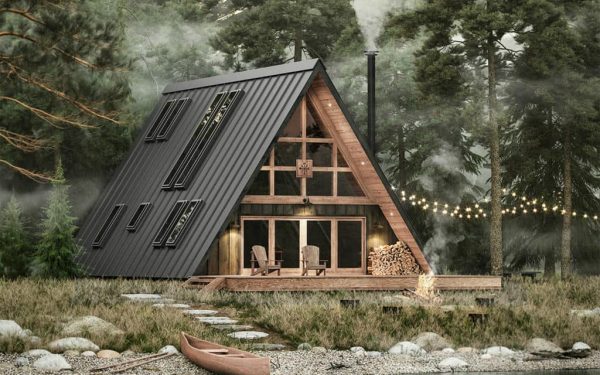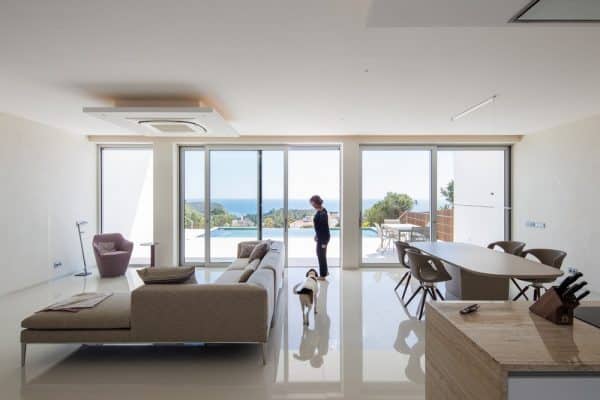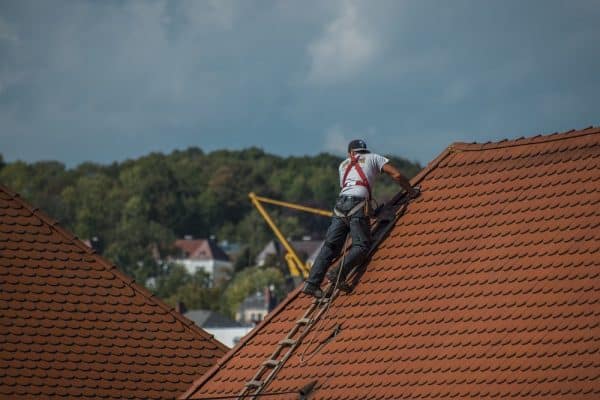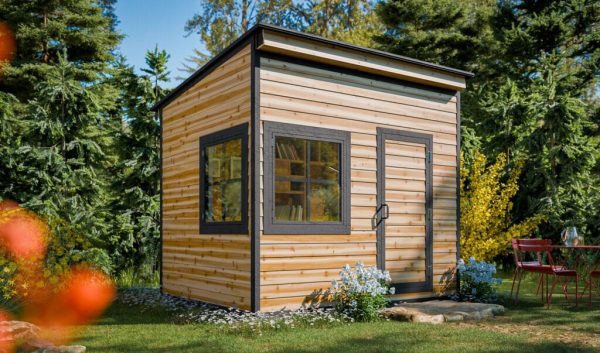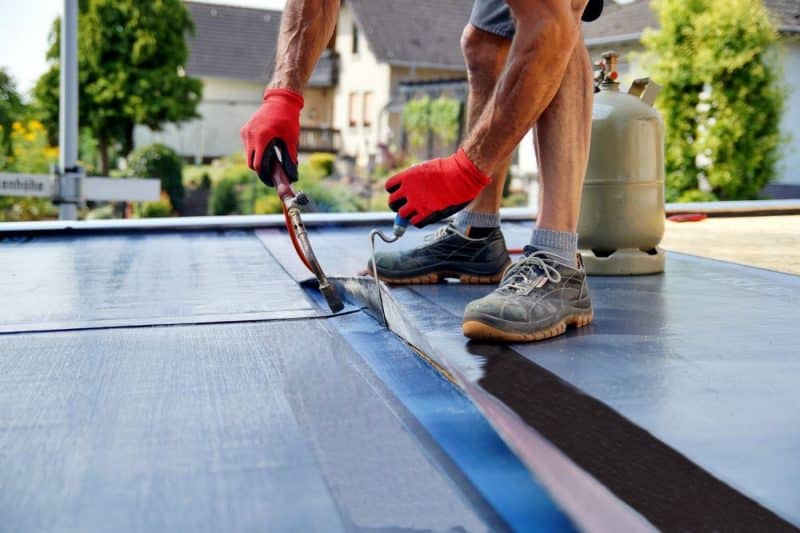
Effective waterproofing is essential for ensuring a building’s longevity and structural integrity. There are three main methods of waterproofing flat roofs: liquid waterproofing, single-ply membranes, and reinforced bitumen membranes. Choosing the best waterproofing for your flat roof can provide the protection required to avoid significant leaking and save you the cost of a roof replacement.
How important is flat roof waterproofing?
Flat roofs have grown in popularity in the UK. Their modern aesthetic appeal fits well with contemporary architectural styles for commercial and residential buildings. However, they are more susceptible to leaks than standard pitched roofs and need the right waterproofing protection.
Ensuring your flat roof is waterproof is essential. This winter was the 8th wettest since records began 150 years ago, and this spring, we had more than one and a half times more rain than average rainfall in March. The Met Office predicts that winters will get wetter and rainfall more intense.
Selecting the best flat roof waterproofing ensures your roof is protected and reduces the risk of structural damage caused by leaks. The cost to replace a flat roof varies depending on size and use, but new residential flat roofs tend to cost between £1,000 and £8,000.
In addition to leak prevention, flat roof waterproofing extends the roof’s lifespan and protects against water damage, mould, and building deterioration. Waterproofing also improves energy efficiency by insulating during the winter and reducing heat from entering the building in the summer.
What are the 3 main methods of waterproofing a flat roof?
Single-ply membrane: This method involves installing a single layer of membrane material over the roof. The membrane is typically made of a long-lasting synthetic polymer.
Liquid waterproofing: This method involves applying a liquid coating to the roof. The coating can be made of various materials, such as polyurethane, acrylic, or silicone.
Reinforced bitumen membranes: This method involves installing two or more bitumen membranes over the roof, which are reinforced with a polyester carrier.
What are the differences between the main methods of waterproofing?
Here are the key differences between the 3 main methods of flat roof waterproofing:
Single-ply membrane:
- Material: Synthetic PVC, TPO, or EPDM.
- Application: Installation involves rolling the membrane sheets over the prepared surface and then adhering or mechanically fastening them.
- Durability: UV and puncture-resistant, long-lasting.
- Installation: Fast installation; no open flames required.
- Cost: The ease of installation makes installation cost-effective, and durability reduces maintenance costs.
Liquid waterproofing:
- Material: Liquid-applied polymer forming a flexible membrane.
- Application: Applied as a liquid, therefore versatile for complex shapes.
- Durability: Seamless, flexible, and low maintenance.
- Installation: Fast and easy to install, but it takes around 72 hours to cure.
- Cost: Variable upfront, potentially cost-effective long-term.
Reinforced bitumen membranes:
- Material: Bitumen reinforced with fiberglass or polyester.
- Application: Installed in rolls, torch or cold-applied.
- Durability: Resistant to weathering and mechanical stress.
- Installation: Skilled labour, torch or cold-applied.
- Cost: Variable based on installation method, generally durable.
What are the single-ply membrane waterproofing materials?
Compared to the different flat roof waterproofing techniques, single-ply membrane flat roof waterproofing stands out as a fast, cost-effective, durable, and reliable option.
Here are the 3 best single-ply membrane waterproofing materials for your flat roof:
1. TPO roofing membrane: TPO (thermoplastic polyolefin) is a single-ply white membrane that is highly reflective and energy-efficient. TPO roofing membranes are expected to last around 25 years.
2. PVC roofing membrane: PVC (polyvinyl chloride) is another single-ply white membrane very similar to TPO in terms of performance and lifespan. However, PVC is more flexible and is commonly used.
3. EPDM roofing membrane: EPDM (ethylene propylene diene terpolymer) is a synthetic rubber black membrane highly durable and resistant to heat, water, and chemicals. It’s a good option for flat roofs over non-living spaces such as garages or workshops. EPDM roofing membranes can last up to 30 years.
What are the benefits of using single-ply membranes for flat roof waterproofing?
Here are the top 3 benefits of using a single-ply membrane for flat roof waterproofing:
Durability: Single-ply membranes, such as EPDM, TPO, and PVC, are highly durable and resistant to UV radiation, weathering, and chemical exposure. They can withstand temperature fluctuations and environmental stresses, ensuring long-term performance.
Flexibility: These membranes can accommodate building movement and settling without cracking or splitting. Their flexibility allows them to adapt to the contours of the roof surface, minimising the risk of leaks at seams and penetrations.
Ease of Installation: Single-ply membranes are typically lightweight and come in large rolls, making them easier and quicker to install than traditional roofing materials. Depending on the installation method and roof design, they can be mechanically attached, adhered, or ballasted.
What should you consider when selecting waterproofing for a flat roof?
Three elements to consider when selecting a waterproofing approach for a flat roof include:
Budgetary considerations: Evaluate various waterproofing options within your allotted budget. Other materials and installation techniques vary in cost, so choose an approach that aligns with your financial resources.
Environmental factors: Examine factors, such as weather conditions and your surrounding environment, that can affect the longevity of the waterproofing material.
Type of structure: When deciding on the right waterproofing for your requirements, consider the size, use, and complexity of your flat roof.
Final thoughts
Selecting suitable waterproofing for a flat roof is a decision that will impact the building’s life – so getting it right is essential. Liquid waterproofing, single-ply membranes, and reinforced bitumen membranes offer unique advantages, from the cost-effective protection and energy efficiency of single-ply membranes to the versatility of liquid waterproofing and the more expensive but durable bitumen.
Environmental exposure, the structure’s specific needs, and budget constraints are pivotal in determining the most suitable waterproofing approach. Choose wisely, and you’ll ensure the longevity and integrity of your flat roofs, safeguarding your investment against the elements.

